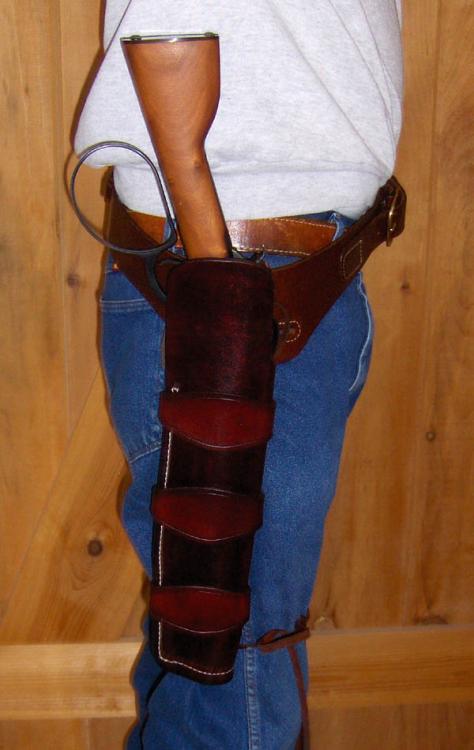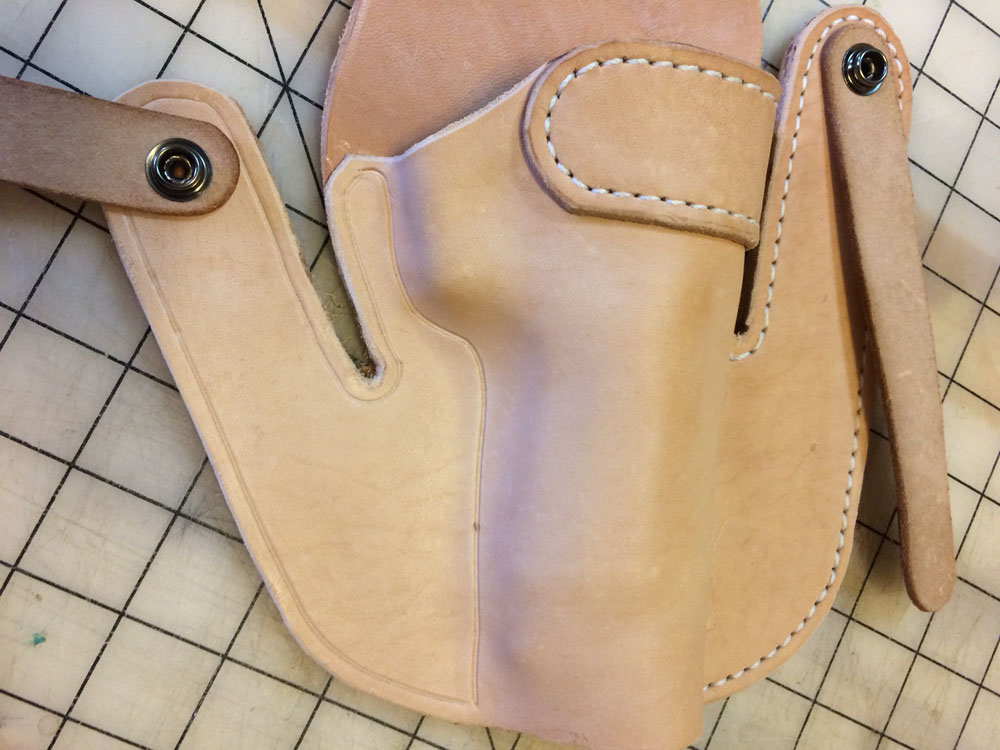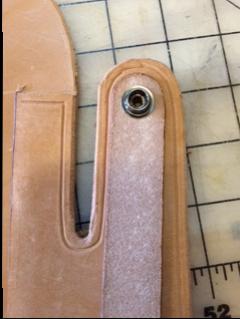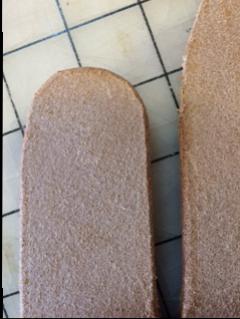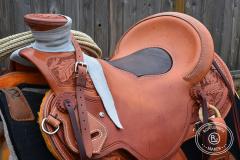-
Posts
5,227 -
Joined
-
Last visited
Content Type
Profiles
Forums
Events
Blogs
Gallery
Everything posted by Dwight
-
Would you seriously dip dye that big of a piece? Of course I would, . . . In order to do that piece, . . . I would find myself a cake pan that was longer than 25 inches, . . . or some similar container. Presently my widest one is only about 20 inches wide, . . . and I rarely use more than 3/4 of a quart of dye in it, . . . start one end through the dye, . . . snake it down over the edge, . . . into the dye, . . . up and out on the other side, . . . the dye is something in the neighborhood of 1/2 inch deep in the bottom of the pan. JMWendt has good results with airbrushing, . . . I prefer dip dyeing, . . . it's just the old saying "more than one way to skin a cat". The biggest piece I recollect dying for a specific job lately, . . . was a tote bag I made for a lady. The big piece was about 18 by 40, . . . dipped, laid out to dry, and cleaned up in less than 10 minutes. May God bless, Dwight
- 22 replies
-
Good job JMWendt, . . . mine is along the same lines, . . . I just made my burnisher myself, . . . mounted it to the motor, . . . turned the motor on, . . . then took various files to the piece of wood to get the grooves I wanted, . . . works like a champ. Part of the lure of leather work to me, . . . it is simply the opportunity to be creative in how one does things, . . . not like a machine shop where dedicated and precisely demanded equipment is necessary. May God bless, Dwight
- 42 replies
-
- edge paint
- polishing
-
(and 1 more)
Tagged with:
-
The reason "People always recommend dip dyeing or spraying when dying big piece" is very simple, . . . it works. If you want to spend all your waking hours trying other ways, . . . have at it, . . . but these are time tried and time proven to be totally effective. Also, . . . I would not sell a product that was not dyed through and through. I've messed around with spray dyeing and only use that for special accents on a product. The base leather is dip dyed through and through. What you save in dye over a 5 year period, . . . you will lose in customer complaints if there is any abrasion or scuffing on a dyed piece such as in the video you linked to. That leather will even lose it's dye color the first time it's owner makes the mistake of leaving it where direct sunlight can bleach it out, . . . that does not happen as readily with dip dyeing. Dip dyeing is in my opinion, . . . THE WAY to do it, . . . has never failed me. May God bless, Dwight
- 22 replies
-
Hey, Pete, . . . don't forget to post up pics of the final product, . . . let us all see your "secret tool". Seriously though, . . . this is one of my favorite forums, . . . sometimes just get on here and read, . . . kind of like the old high school cafeteria where you could just go sit down, . . . and catch snippets of a half dozen conversations all at the same time. Those were fun times many moons ago, . . . but this forum, . . . in it's own way, . . . brings that back to life again. May God bless, Dwight
-
An 80 inch blank when finished gives me a 70 inch belt, . . . I don't know who you are making belts for, . . . but I've really never made one for a 70 inch person. OTOH, . . . double shoulders give good blanks for belts in the 44 inch and shorter category, . . . and when you quit cutting blanks off the one side, . . . the rest of the piece makes really good holsters. And double shoulders are generally much less expensive than sides. They are what I use, . . . with an occasional side thrown in so I can have the 50+ belt for my more rotund customers. May God bless, Dwight
-
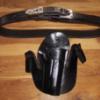
Third Holster. First Thumb Break.
Dwight replied to SLP's topic in Gun Holsters, Rifle Slings and Knife Sheathes
Looks good from this end. If you had made it for me, . . . I'd be proud to wear it. But then again, . . . 1911's and leather were made for each other like apple pie and ice cream. May God bless, Dwight- 6 replies
-
- holster
- thumb break
-
(and 4 more)
Tagged with:
-

Mare's Leg rig
Dwight replied to plinkercases's topic in Gun Holsters, Rifle Slings and Knife Sheathes
I'm not too sure how fast it might be or might have been, . . . but I did this one some time back. I'd much druther carry my 1911............. May God bless, Dwgiht -
Thanks Red Cent for the update, . . . sorry to hear that. May God bless, Dwight
-

A new Holster with a
Dwight replied to OLDNSLOW's topic in Gun Holsters, Rifle Slings and Knife Sheathes
Chiefjason is correct, . . . you can get away with that, . . . I usually just start over....... But about those "TEE" nuts, . . . I just wanted to make an observation. I don't use them that way, . . . and the reason is that I sweat like a Democrat at a GOP rally, . . . and the plating just will not last very long with me, . . . then it's rust all over my undershirts or my regular shirt, . . . and an unhappy wife. I normally use regular snaps, . . . but only go through the leather strap and the outermost layer, . . . then use the innermost layer to cover it up, . . . and no rust. Just sharing a different way to do this. May God bless, Dwight -

A new Holster with a
Dwight replied to OLDNSLOW's topic in Gun Holsters, Rifle Slings and Knife Sheathes
My guess is that you used contact cement, . . . and that is one of the bad traits of CC, . . . you get it where you did not want it, . . . too bad, . . . it will not take dye. About the best I'd suggest is using a black "Sharpie" or other black permanent magic marker, . . . but even then, . . . it'll take several applications. I learned long ago to stay a distance from the line around any glued on piece so that very thing would not happen. Are you using "Tee" nuts to hold on your straps?? May God bless, Dwight -

Tuckable IWB for XDs
Dwight replied to Josh Ashman's topic in Gun Holsters, Rifle Slings and Knife Sheathes
Good job !!!! May God bless, Dwight -
Uhh, . . . John Wayne and Clint Eastwood didn't like Glocks............ But, anyway, . . . I have never made one as you have described, . . . but I have built many holsters for 1911's which have a similar frame. It can be done, . . . what you want to do is get a copy of John Bianchi's western holster making DVD's or VHS tapes. Either one will show you the mechanics of making a holster like that, . . . and if you take your time, . . . it will be a holster you will be proud of. You most likely do not have a sewing machine, . . . so instead of making it with two layers of 6/7 oz veggie tan, . . . you can use one layer of 8/9 oz or 9/10 oz and achieve a good looking holster much like John Wayne used in True Grit or a couple of his other Western movies. You will have to sew one seam, . . . the seam that will be under the trigger guard and the light. You will also want to make it a closed bottom and let the weapon rest on the front of the flashlight instead of the muzzle of the gun. If you don't find anything (try Ebay) let me know by PM, . . . I have a couple of Glock blue guns, . . . and could probably whip up some kind of rough pattern for you. Do you also want to tool it, . . . decorate it with concho's, . . . or anything like that? May God bless, Dwight
-
My belts are all made of two pieces of leather, . . . usually cut back to back from the same hide, . . . put together with Weldwood contact cement, . . . then stitched. My belts run less than .250, . . . that is just on the very edge of being too thick. I am actually wearing one that thick right now, . . . but very few of my clients like them that thick. I did do some work for a local LEO, . . . his commercially made belt was exactly that thick, . . . and if I recollect correctly, . . . was 2 1/2 inches wide. His was also stitched. No, . . . I would not use raw hide, . . . veggie tan was made for belts, . . . makes the best looking and they are long lasting. May God bless, Dwight
-

Pancake holster construction
Dwight replied to JLSleather's topic in Gun Holsters, Rifle Slings and Knife Sheathes
I've found the one on the right is a bit more uncomfortable for me, . . . mainly because I'm one bony guy. Not much lard or meat on these bones, . . . maybe a bit hanging over the buckle out front, . . . but even that is not much. All that said, . . . the one on the right is a "pain cake" for me, . . . much prefer the one on the left. But also, . . . though it is the same thickness, . . . because it does not get pulled in next to my bony old self, . . . it does protrude a bit more. Not much, . . . but then you don't need much to look out of place. But that's just my take on the discussion, . . . YMMV May God bless, Dwight -

KNife sheath for Marine Corpsman
Dwight replied to Albob's topic in Gun Holsters, Rifle Slings and Knife Sheathes
I've always been a fan of this particular knife, . . . have one given to me by the mother of a young marine whose life was taken by sickness. You did a great job on that sheath, . . . kudos to you, my friend. May God bless, Dwight -

Where can I find a Oval punch to make this design?
Dwight replied to Beardedbandana's topic in Suppliers
Without dimensions, . . . it's pretty tough to figure on an improvisation, . . . but I have better than half of my punches made from galvanized electrical conduit. Generally, . . . I take it to a sander, . . . sand off a bevel on the outside edge to make a cutting surface on the end, . . . then cut / form / bend / that end so that when I whack it with a mallet, . . . it cuts out what i want. What are the dimensions of the project? May God bless, Dwight- 9 replies
-
- hand tools
- punch
-
(and 1 more)
Tagged with:
-
"It's only happened twice in about 100 years........." I had to laugh, . . . my "big" story is a guy wanted a cowboy gun belt and holster like John Wayne's. We agreed on price and delivery. He measured out at 53 inches, . . . and I always follow John Bianchi's advice of making it 4 inches longer, . . . which made a 57 inch belt. I made it, . . . called him, . . . he came to pick it up. It was 3 inches too short, . . . as he had gained 3 inches in the processing time. Fortunately, . . . I was able to put a new tongue on it, . . . and it worked out. Don't want any more of those.............. May God bless, Dwight
-
Thanks, Thor and rd123, . . . it was just one of those "hmmmm" moments we all get from time to time, . . . and I originally wanted to just throw my questions anad observations over to "fashion" and let it go at that. The wrap was what got me to ask, . . . I knew there was something more than I knew about it. I purchased an old "Jumbo" saddle from a pawn shop in Colorado, . . . it's most likely at least several years older than I am, . . . was once a beautiful saddle, . . . but has been "cowboy" repaired a few times. It has a larger horn, leather wrapped, and has a piece of black garment leather glued around it. Now I know the why and how to some of my questions, . . . and I just wanted to say thanks. Oh, and, . . . yes, I have ridden the saddle, . . . and it is a comfortable one. But it spends most of its time sitting on a home made saddle stand, adorning the entrance to my leather shop. May God bless, Dwight
-
Hey, guys, . . . simple question for all saddle makers, fixers, etc. When I was a youngster growing up in the 50's and early 60's, lots of people around our area had horses and / or ponies. ALL THE SADDLES had relatively thin, chrome polished, saddle horns. Now, . . . they are all fat, . . . leather covered, . . . and it seems lately that they all are covered in some kind of grey leather, . . . vinyl, . . . or some kind of product. Can someone explain the how and why of the changes, . . . would love to hear it. May God bless, Dwight
-

What Finish To Use
Dwight replied to craftsman827's topic in Dyes, Antiques, Stains, Glues, Waxes, Finishes and Conditioners.
I don't see any problem with using Resolene on those bags. Resolene only has problems (in my experience at least) in real sharp bends, . . . for example the bend at the buckle end of a man's belt. I always preform them, then put on the Resolene, . . . have never had one crack since. Again, . . . I'd probably take a 6 inch square of the same leather used for the bags, . . . and do everything to it you did to the bag, . . . then a 50/50 Resolene and water, . . . it should give you a really good protective finish. AND, . . by the way, . . . they look good from what I could see. I'd be proud of them if they were my creation. May God bless, Dwight -

What Finish To Use
Dwight replied to craftsman827's topic in Dyes, Antiques, Stains, Glues, Waxes, Finishes and Conditioners.
Carrieanna1172, . . . I have never used the snow proof weather proof stuff you mentioned, . . . cannot say good or bad about it. Resolene, . . . though, . . . I've been using for a number of years, . . . and it's a great product. I always thin it with water, . . . half Resolene / half water, . . . give it a couple of shakes, . . . you're good. I put it on with a bristle brush, . . . it usually is a fairly thin coat, . . . but you can add coats to get the thickness you want. One word of caution, . . . make sure your saddle bags are all formed to the shape you want them, . . . a severe bend in the Resolene after applying and drying can result in a crack in the finish that you WILL NOT like. I'd try a test area first, . . . make sure whatever is on there will not lift the finish off, . . . and go from there. Post some pics and let us see what you are doing. May God bless, Dwight -
Of all the bikes in the last few years I've seen, . . . I'd say that is one I would not mind owning. So many of them around here are black and chrome, . . . black and chrome, . . . black and chrome. Boring does not describe them all adequately. This is a refreshing and beautiful change of pace. May God bless, Dwight
-
Thanks, Albob...... I wasn't sure what kind of snakes you were mentioning, . . . only ones I knew of in the San Diego area that would need a .44 mag, . . . mostly drank a lot, swore a lot, and wore either a skirt or britches. But, . . . all in all, the rig looked good, . . . and she seemed to be enjoying it. That last phrase is the most important part of it for me as far as leather working is concerned. If my customer is happy, . . . I'm happy, . . . looks like you hit a home run with her. May God bless, Dwight
-
Weldwood contact cement, . . . properly applied. May God bless, Dwight
-
I don't know enough about saddle structure and this riding sport, . . . but from a leather working standpoint: 5 stars my friend............ May God bless, Dwight



